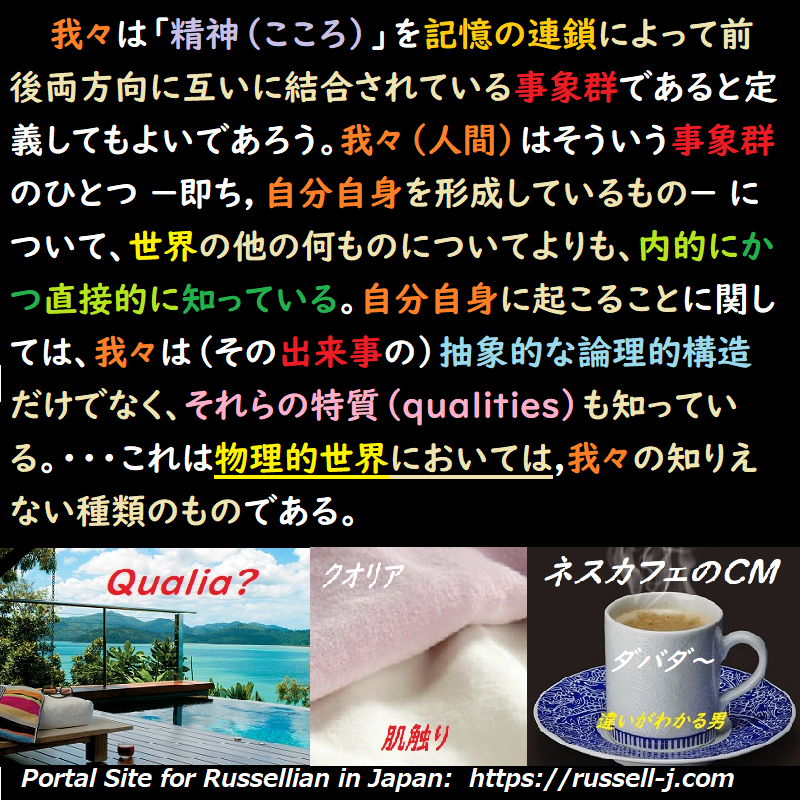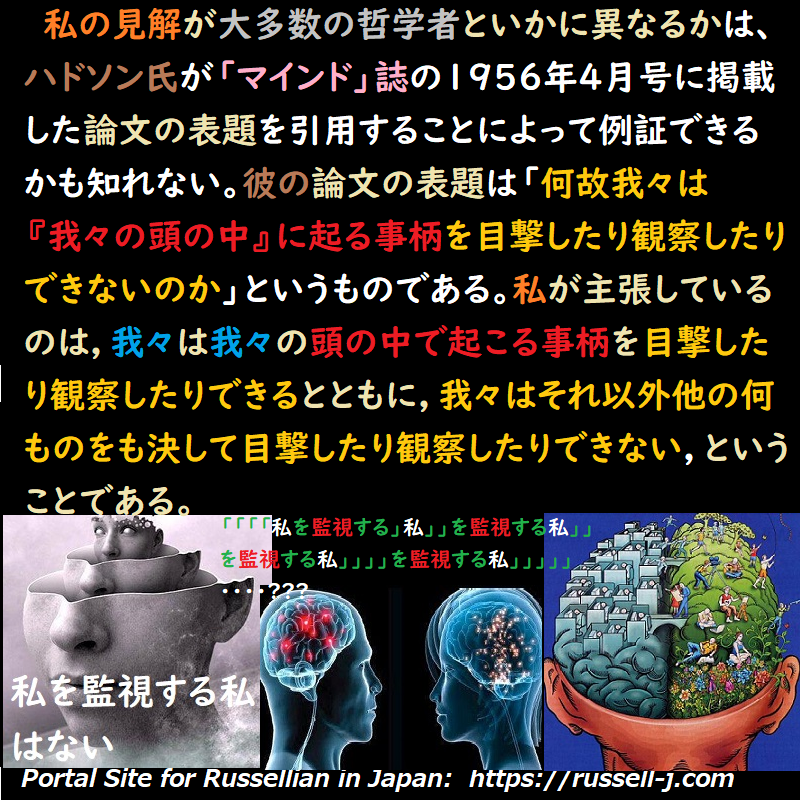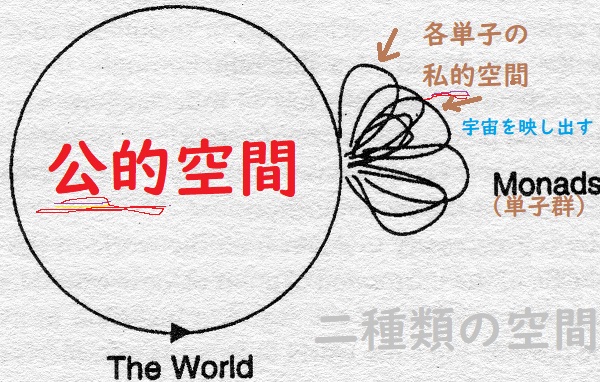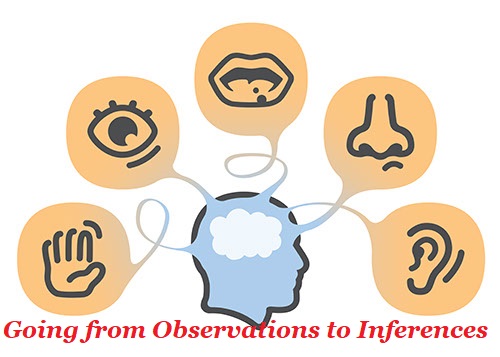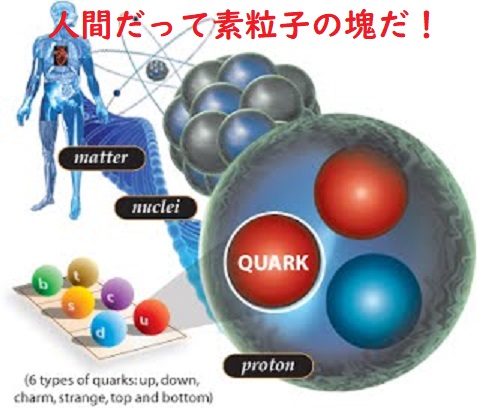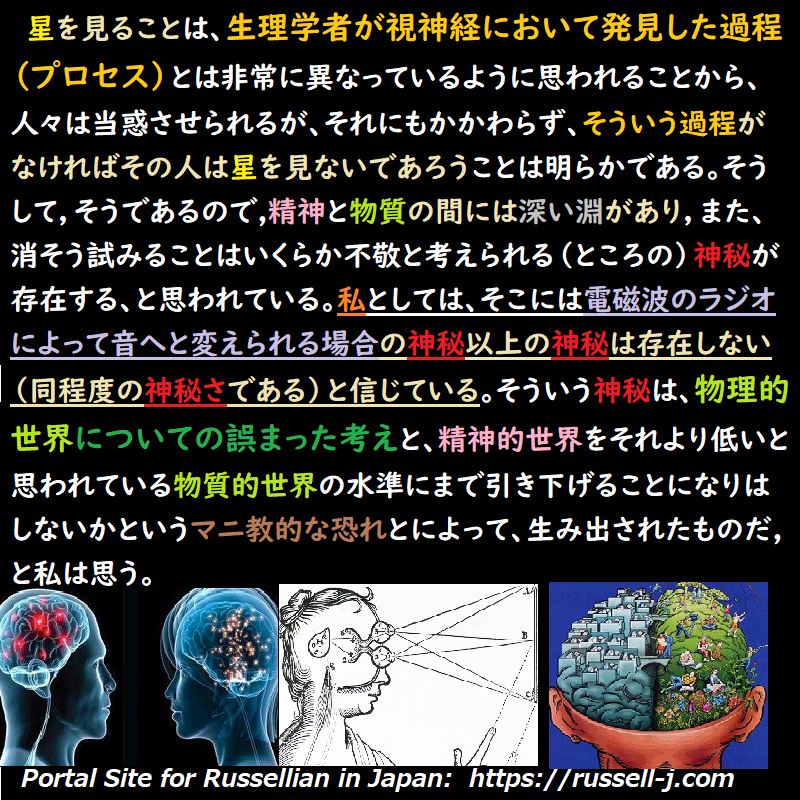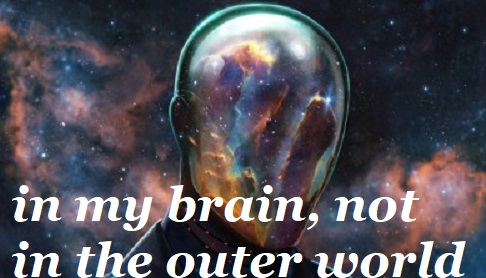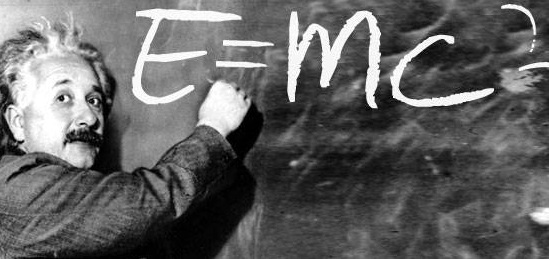我々はもう一つ別のルートを通って同じ結果に接近することが可能である。我々が星空の一部を写真に映す写真乾板について考察していた時、それには写真乾板上において,非常に多数の出来事(a great multiplicity of occurrences)が伴っている(含まれている)のを見た。即ち最小限に見積もっても、その写真乾板が映しうる対象の一つに対して一つの出来事(が存在している)。(そこで)私はこう推論する。「時空」のあらゆる小さな領域において、互いに(部分的に)重なりあっている膨大な数の事象(群)が存在し、その事象(群)の各々は因果の線(causal line)によってそれより以前の時点 -通常はほんの少し前の時点であるけれども- に生じた一つの源(origin 発生源の出来事)と結ばれている(と)。写真乾板のような感知装置(a sensitive instrument)は,それがどこに置かれていようとも、それらの因果の線を発出する多種多様な対象を -ある意味で- 「知覚する」と言ってよいだろう。通常,我々は当の装置(instrument in question 問題となっている装置)が、生きている脳でなければ「知覚する」という語を用いないが、それは(それを「知覚する」というのは)、生きている脳によって占められている領域の中に起る(諸)事象の間に、ある一定の特別な関係が存在するからである(注:観測装置がとらえたものを人間が覗くと脳のなかでそれに対応した事象が起こる,つまり生きた脳とのつながりができる)。この特殊な関係の中で最重要なものは記憶である。このような特別な関係が存在するあらゆる場所に「知覚者(a percipient)が存在する」と我々は言う。我々は「精神(こころ)」を記憶の連鎖によって前後両方向に互いに結合されている事象群(事象の集合)であると定義してもよいであろう。我々(人間)はそういう事象群のひとつ -即ち,自分自身(ourself)を形成しているもの- について、世界の他の何ものについてよりも、内的にかつ直接的に知っている(注:たとえば、他人が何を考えているかわからないが、自分が今何を考えているかは自分はよく知っている,と思っている/なお,ourselves ではなく ourself 私自身=自分自身となっていることに注意)。自分自身(の身に)起こることに関しては、我々は(その出来事の)抽象的な論理的構造だけでなく、それらの特質(qualities 特別な性質)も知っている。ここで(諸)特質の意味するものは、たとえば「色」に対して「音」を特徴づけるものであり、あるいは,「緑」に対して「赤」を特徴づけるものである(注:たとえば、「肌ざわり」のようなものや「なまあたたかさ」のような質感は他人にはわからない)。これは物理的世界においては我々の知りえない種類のものである。
Chapter 2: My present view of the world, n.12 We can approach the same result by another route. When we were considering the photographic plate which photographs a portion of the starry heavens, we saw that this involves a great multiplicity of occurrences at the photographic plate: namely, at the very least, one for each object that it can photograph. I infer that, in every small region of space-time, there is an immense multiplicity of overlapping events each connected by a causal line to an origin at some earlier time – though, usually, at a very slightly earlier time. A sensitive instrument, such as a photographic plate, placed anywhere, may be said in a sense to ‘perceive’ the various objects from which these causal lines emanate. We do not use the word ‘perceive’ unless the instrument in question is a living brain, but that is because those regions which are inhabited by living brains have certain peculiar relations among the events occurring there. The most important of these is memory. Wherever these peculiar relations exist, we say that there is a percipient. We may define a ‘mind’ as a collection of events connected with each other by memory-chains backwards and forwards. We know about one such collection of events – namely, that constituting ourself – more intimately and directly than we know about anything else in the world. In regard to what happens to ourself, we know not only abstract logical structure, but also qualities – by which I mean what characterizes sounds as opposed to colours, or red as opposed to green. This is the sort of thing that we cannot know where the physical world is concerned.
Source: My Philosophical Development, chap. 2,1959.
More info.:https://russell-j.com/beginner/BR_MPD_02-120.HTM
月別アーカイブ: 2021年5月
ラッセル『私の哲学の発展』第2章 私の現在の世界観 n.11
このことの大部分は、ほとんど修正(変更)なしに、私が擁護したい理論(説)の実例として応用可能である。(即ち)私の知覚の世界における空間があり、また物理学における空間(の2種類)がある。私の知覚における空間の全体は、ライプニッツにとってと同様私にとっても、物理的空間の極くちっぽけな領域を占めるにすぎない。けれども,私の理論(説)とライプニッツの理論(説)との間には重要な相違があり、それは(その相違は)因果律(causality 因果説:全てのことには原因があるとする考え方)のについての異なる概念(考え方の違い)及び、相対性理論の導く諸帰結、に関係がある。私の考えでは,物理的世界の時空(space-time 相互に影響しあう一体としての時間+空間)の秩序は因果関係(causation)と密接な関係があり(is bound up with)、その因果関係はまた、物理的過程の非可逆性(irreversibility)と密接な関係がある。古典物理学においては全てのものは可逆的(注:一度起きた変化がまた元に戻ることができる性質)であった。もし(この宇宙の)物質の全ての断片を、以前と同じ速度で、(今の進行方向とは)逆向きに動かし始めたなら、宇宙の全歴史は、逆向きに(逆方向に)展開して行くであろう(注:ビッグバンにより宇宙は拡大しているが、逆向きにすればビッグクランチして最後には点となるはず)。(だが)現代物理学は熱力学の第二法則(the Second Law of Thermodynamics)を出発点として、この見方を熱力学においてだけでなく他のいかなる場合においても捨て去った(注:不可逆だということ)。放射性原子(注:radioactive atoms 放射能をもった原子/放射性同位元素:原子核が崩壊して何らかの放射線を放出する同位元素のこと)は崩壊し(disintegrate)、再結合すること(注: put themselves together again 再び元のように集まってひとつになること)はない。一般的に言って、物理的世界における諸過程(プロセス)は全て,原因と結果とを区別するような(一つ))方向(性)をもっており、この原因と結果との区別は古典物理学においては存在していなかったものである。物理的世界の時空の順序にはこの方向(性)のある因果律が含まれている(伴っている),と私は考える。あらゆる哲学者がぞっとする(find shocking 衝撃だと思う)ある意見(見解)を私が主張するのは、まさにこの理由に基づいている。即ち,その意見(見解)とは,人々の思考・思想は人々の頭の中(脳内)にあるというものである。星からの光は介在する空間を通り、視神経において撹乱を生じさせ,脳内の(一つの)出来事で終わる。私が主張するのは、脳内のその出来事が(一つの)視覚(a visual sensation)であるということである。私は,実際、-デカルトが用いたような,最も広義の意味で- 脳は思考から成っている,と主張する。これに対し,人々は次のように返答するだろう。「馬鹿を言うな! 私は顕微鏡(注:今なら電子顕微鏡)を通して脳(内)を見ることができ,また(しかも)脳が思考から成っておらず、ちょうど机や椅子と同じ物質から成っていることを見ることができる」。これは全くの誤まりである。あなたが顕微鏡を通して脳(内)を眺める時、あなたの目に見えるもの,はあなた自身の私的世界の一部である。 それ(あなたの私的世界の一部)は,自分が眺めている(注目している)とあなたが言う(ところの/対象の)脳から始まる長い因果の過程があなたのうちに生み出した結果(effect 影響/効果)である。あなたが眺めているとあなたが言う脳は、疑いもなく、物理的世界の一部分である。しかしそれ(物理的世界の一部)はあなたの経験における一所与(与件/データ)であるところの脳ではない(注:要するに、物理的世界と私的世界を混同するなかれ)。その私的世界の脳は物理的脳の生んだ一つの遠隔効果(a remote effect)である。そして、もし私が主張するように、物理的「時空」における事象の位置(location あり場所)が、因果関係によって影響される(運命にある)とするならば、(その場合には)あなたの知覚内容 -、それは眼や脳に向かう視神経における事象が起こった後に生ずるもの(である)- は,あなたの脳内にそのあり場所を位置づけられなければならない。私の見解(意見)が大多数の哲学者といかに異なるかは、ハドソン(H.Hudson)氏が「マインド」誌の1956年4月号に掲載した論文の表題を引用することによって例証できるかも知れない。彼の論文の表題は「何故我々は『我々の頭の中』に起る事柄を目撃したり観察したりできないのか」というものである。私が主張しているのは,我々は我々の頭の中で起こる事柄を目撃したり観察したりできるとともに,我々はそれ以外他の何ものをも決して目撃したり観察したりできない,ということである。
Chapter 2: My present view of the world, n.11 Most of this can be applied with little change to exemplify the theory that I wish to advocate. There is space in the world of my perceptions and there is space in physics. The whole of the space in my perceptions, for me as for Leibniz, occupies only a tiny region in physical space. There is, however, an important difference between my theory and that of Leibniz, which has to do with a different conception of causality and with consequences of the theory of relativity. I think that space-time order in the physical world is bound up with causation, and this, in turn, with the irreversibility of physical processes. In classical physics, everything was reversible. If you were to start every bit of matter moving backwards with the same velocity as before, the whole history of the universe would unroll itself backwards. Modern physics, starting from the Second Law of Thermo-dynamics, has abandoned this view not only in thermodynamics but also elsewhere. Radioactive atoms disintegrate and do not put themselves together again. Speaking generally, processes in the physical world all have a certain direction which makes a distinction between cause and effect that was absent in classical dynamics. I think that the space-time order of the physical world involves this directed causality. It is on this ground that I maintain an opinion which all other philosophers find shocking: namely, that people’s thoughts are in their heads. The light from a star travels over intervening space and causes a disturbance in the optic nerve ending in an occurrence in the brain. What I maintain is that the occurrence in the brain is a visual sensation. I maintain, in fact, that the brain consists of thoughts – using ‘thought’ in its widest sense, as it is used by Descartes. To this people will reply ‘Nonsense! I can see a brain through a microscope, and I can see that it does not consist of thoughts but of matter just as tables and chairs do.’ This is a sheer mistake. What you see when you look at a brain through a microscope is part of your private world. It is the effect in you of a long causal process starting from the brain that you say you are looking at. The brain that you say you are looking at is, no doubt, part of the physical world ; but this is not the brain which is a datum in your experience. That brain is a remote effect of the physical brain. And, if the location of events in physical space-time is to be effected, as I maintain, by causal relations, then your percept, which comes after events in the eye and optic nerve leading into the brain, must be located in your brain. I may illustrate how I differ from most philosophers by quoting the title of an article by Mr H. Hudson in Mind of April 1956. His article is entitled, ‘Why we cannot witness or observe what goes on “in our heads”.’ What I maintain is that we can witness or observe what goes on in our heads, and that we cannot witness or observe anything else at all.
Source: My Philosophical Development, chap. 2,1959.
More info.:https://russell-j.com/beginner/BR_MPD_02-110.HTM
ラッセル『私の哲学の発展』第2章 私の現在の世界観 n.10
(私自身の見解を)ライプニッツの見解と比較することによって、多分,私の見解を最も明確にできるだろうと思う。ライプニッツは,宇宙は(多数の)単子(モナド)から成っており、各単子のいずれも一つの小さな精神であって、それぞれの単子はこの宇宙を映し出している、と考えた。各単子は様々な程度の不正確さで宇宙を映す。最上の単子(注:複数)は(単子が映す)宇宙像において混乱が最も少ない。ライプニッツは、アリストテレスの主語述語論理(学)によって誤り導かれ、単子は相互に作用し合わないとともに、単子が同一の宇宙を映し続けるという事実は予定調和(pre-established harmony)によって説明されるべきである、と考えた。彼の学説のこの部分は全く受けいれられない。我々がこの世界を映す限りにおいて(in so far as),我々がこの世界を映すのは,外界(外部世界)が我々に及ぼす因果作用(causal action)を通してのみである(可能である)(訳注:”action”は人間の場合は「行為」だが,物が働く場合は「作用」)。しかし,彼の学説には別のいくつかの側面があり、それは私が擁護したい理論(説)とより一致している。それらの側面のなかで最も重要なもののひとつは空間に関するものである。ライプニッツにとって空間には2種類あった。(ただし,この点について、彼は決して明確ではなかった。)(即ち)各単子の持つ私的世界における空間があり、それは(それぞれの単子に与えられる)所与(与件/データ)以上の何ものをも仮定(想定)することなしに、それらの所与(与件)を分析し配列することによって知ることができる(ところの)空間である。しかし,またもうひとつの種類の空間も存在する(とライプニッツは考える)。ライプニッツは,各単子は各自の観点(視点)から世界を映しており,観点の相違は視野の相違に相似している,と言う。多くの観点を集めたものを整理したもの(arrangement)は,我々に各単子の私的世界における空間とは異なるもうびとつの種類の空間を与える。この公的空間(public space 公共空間)において、各単子は一つの点、あるいは,ともかくも,非常に小さな領域を占める。私的世界にも私的空間があってそれはその私的な観点(視点)から見ると無限であるけれども、この(私的には)無限な(空間の)全体は、その単子が他の多くの単子の間に置かれる時にはとても小さな一点に収縮する。我々は各単子の所与(与件)の世界における空間を「私的」空間と呼び、多種多様な単子の多種多様な観点の集まりからなる空間を「物理的」空間と呼んでもよいだろう。(各)単子が世界を正しく映すかぎり、「私的」空間の幾何学的諸特性は、物理的空間の幾何学的諸特性と相似するであろう。
Chapter 2: My present view of the world, n.10
I think perhaps I can best make my own views clear by comparing them with those of Leibniz. Leibniz thought that the universe consisted of monads, each of which was a little mind and each of which mirrored the universe. They did this mirroring with varying degrees of inexactness. The best monads had the least confusion in their picture of the universe. Misled by the Aristotelian subject-predicate logic, Leibniz held that monads do not interact, and that the fact of their continuing to mirror the same universe is to be explained by a preestablished harmony. This part of his doctrine is totally unacceptable. It is only through the causal action of the outer world upon us that we reflect the world in so far as we do reflect it. But there are other aspects of his doctrine which are more in agreement with the theory that I wish to advocate. One of the most important of these is as to space. There are for Leibniz (though he was never quite clear on this point) two kinds of space. There is the space in the private world of each monad, which is the space that the monad can come to know by analysing and arranging data without assuming anything beyond data. But there is also another kind of space. The monads, Leibniz tells us, reflect the world each from its own point of view, the differences of points of view being analogous to differences of perspective. The arrangement of the whole assemblage of points of view gives us another kind of space, different from that in the private world of each monad. In this public space, each monad occupies a point or, at any rate, a very small region. Although in its private world there is a private space which from its private point of view is immense, the whole of this immensity shrinks into a tiny pin-point when the monad is placed among other monads. We may call the space in each monad’s world of data ‘private’ space, and the space consisting of the diverse points of view of diverse monads ‘physical’ space. In so far as monads correctly mirror the world, the geometrical properties of private space will be analogous to those of physical space.
Source: My Philosophical Development, chap. 2,1959.
More info.:https://russell-j.com/beginner/BR_MPD_02-100.HTM
ラッセル『私の哲学の発展』第2章 私の現在の世界観 n.9
しかし、我々のこの世界は,全てが推論の問題(a matter of inference)であるわけではない。科学者の意見を聞かなくても,我々が知っている物事はある。(たとえば)もし,我々が暑すぎたり,寒すぎたりすれば、暑さや寒さは何からなっているかについて物理学者に尋ねなくても、我々はその事実(暑い寒い)に完璧に気づくことができる。他人の顔を見る時、我々(you)は全く疑う余地のない経験をする。しかし,その経験は理論物理学者が語るようなものを見ることからなっていない。我々は他人の眼を見る。そうして,他人もまた我々の眼を見ていると信じる。視対象(visual objects 視覚上の対象)としての我々自身の眼は、(この)世界の中の推論された部分に属している。ただし,この推論は,鏡や写真やあなたの友人の証言によって,かなり疑うことのできないものになっている。(訳注:鏡で自分の眼を見ていろいろ思い巡らすような状況を考えるとよい?)視対象(視覚対象)としての自分自身の眼に対する推論は、物理学者が電子等に対して行う推論と,本質的に同種のものである。だから,もし物理学者の推論の妥当性を否定しようとするならば、我々は自分が視覚の対象としての眼を持っているという知識をもまた否定しなければならない(訳注:つまり,物理学者があなたの眼を科学的に観察することと、自分が鏡の向こうに見える自分の眼を観察することは同種の推論だということ)。ユークリッドが(よく)言っているように,これは馬鹿げている(不合理である)。(注:野田氏は、「ユークリッドの言い方をまねれば、これは背理である」と訳しているが、absurd を「背理(パラドクス)」と訳すのは感心しない。) 我々が推論なしで気づく全てのものに「所与(与件)」(data:与えられたもの,与えられたデータ)という名を与えてよいであろう。「所与(与件)」には,我々が観察したあらゆる感覚(されたもの) -視覚、聴覚、触覚等-が含まれている。(我々の)常識は、我々(人間)の感覚の多くは、我々の身体の外部にある原因のせいだとする理由があると理解する(sees reason)。常識は,常識(を持った自分)の座っている部屋が、常識(を持った自分)が眼を閉じたり眠ったりすると存在しなくなるとは信じない(注:単数形の “it”は,前後関係から,「常識(Common sense)」としか解釈できない。しかし,「常識」だけでは変な訳文になってしまうので,長いですが「常識(を持った個人)と訳しています)。常識(を持った自分)は,自分の妻や子供は自分の想像の単なる作り物(figments 虚構)に過ぎないなどとは信じない。これらすべての点で我々は(自分たちの)常識に同意するかもしれない。しかし,(我々の)常識が間違うのは、無生物の対象が、その本質において、それが(原因となって)引き起こす知覚に似ていると想定すること(場合)においてである。そのように信ずることは、蓄音機のレコードがそれの生み出す音楽と似ていると考えるのと同様に根拠のないことである。しかしながら私が主として強調したいことは、物理的世界と所与の世界との相違なのではない。けれども,私が主として強調したいのは、物理学の世界と所与(与件)の世界の間にある「相違」ではない。それどころか逆に,私が明らかにすることが重要だと考えているのは、物理学が一見そう思わせるよりもずっと多くの密接な相似が両者の間にある可能性があるということである。
Chapter 2: My present view of the world, n.9
But our world is not wholly a matter of inference. There are things that we know without asking the opinion of men of science. If you are too hot or too cold, you can be perfectly aware of this fact without asking the physicist what heat and cold consist of. When you see other people’s faces, you have an experience which is completely indubitable, but which does not consist of seeing the things which theoretical physicists speak of. You see other people’s eyes and you believe that they see yours. Your own eyes as visual objects belong to the inferred part of the world, though the inference is rendered fairly indubitable by mirrors, photographs and the testimony of your friends. The inference to your own eyes as visual objects is essentially of the same sort as the physicist’s inference to electrons, etc.; and, if you are going to deny validity to the physicist’s inferences, you ought also to deny that you know you have visible eyes – which is absurd, as Euclid would say. We may give the name ‘data’ to all the things of which we are aware without inference. They include all our observed sensations – visual, auditory, tactile, etc. Common sense sees reason to attribute many of our sensations to causes outside our own bodies. It does not believe that the room in which it is sitting ceases to exist when it shuts its eyes or goes to sleep. It does not believe that its wife and children are mere figments of its imagination. In all this we may agree with common sense; but where it goes wrong is in supposing that inanimate objects resemble, in their intrinsic qualities, the perceptions which they cause. To believe this is as groundless as it would be to suppose that a gramophone record resembles the music that it causes. It is not, however, the difference between the physical world and the world of data that I chiefly wish to emphasize. On the contrary, it is the possibility of much closer resemblances than physics at first sight suggests that I consider it important to bring to light.
Source: My Philosophical Development, chap. 2,1959.
More info.:https://russell-j.com/beginner/BR_MPD_02-090.HTM
ラッセル『私の哲学の発展』第2章 私の現在の世界観 n.8
我々がこれまで述べてきた世界は全く推論された(推論による)世界である。我々は物理学が語るような種類の存在(注:素粒子など)を知覚しない(知覚することはない)。また,物理的世界がそういう存在から構成されているとしたら、我々は眼や視神経を理解しない(do not see/理解しない)ということになる。というのは、(人間の)眼や視神経は,等しく、もし物理学者の言うことを信じるなら、理論物理学者が我々に親しませようと試みているあの奇妙な仮説的な存在から成っているからである。けれども、それらの存在の信用性は推論に負っているのであるから、その推論上の目的をそれらの存在が果すのに必要な程度にのみ定義されているにすぎない。電子や陽子や中性子や中間子や光子(pliotons)その他が、経験の直接的対象に属するところの単純な実在性を持つと想定する必要はない。それらはたかだか(at best)(たとえば)「ロンドン」という語が持っているような実在性を持っているだけである。「ロンドン」という語は便利な語であるが、この語を用いて述べられるあらゆる事実は、もっと手数がかかるけれども(cumbrously 煩わしい)、それを用いないで述べることが可能である。けれども,ロンドンと電子との間には一つの相違があり、しかも重要な相違がある。我々はロンドンを構成している様々な部分を見ることができ、そうして,実際に、部分(注:ロンドンの一部)の方が(ロンドン)全体よりもより直接的に我々に知られている(直接的に知っている)。電子の場合においては、我々はそれを知覚せず、また、電子を構成しているものだと我々が知っているいかなるものも知覚しない。我々は,電子をある理論的目的を満たすところの仮説的な存在としてのみ知っている。理論物理学に関する限り、そういう目的を満たすものならばいかなるものでも電子だと考えて取り扱うことが可能である。電子は単純であるかも知れないし、複合的なものであるかも知れない。もし電子が複合的なものであるとしても、その構成要素は、合成の結果として生ずる構造が、電子の必要とする特性を持ちうるのであれば、どのようなものであってもよい。そしてこれら全てのことは、無生物の世界にのみならず、眼やその他の感覚器官、神経及び脳にも等しくあてはまる。
Chapter 2: My present view of the world, n.8 The world of which we have been speaking hitherto is entirely an inferred world. We do not perceive the sort of entities that physics talks of, and, if it is of such entities that the physical world is composed, then we do not see the eye or the optic nerve, for the eye and the optic nerve, equally, if the physicist is to be believed, consist of the odd hypothetical entities with which the theoretical physicist tries to make us familiar. These entities, however, since they owe their credibility to inference, are only defined to the degree that is necessary to make them fulfil their inferential purpose. It is not necessary to suppose that electrons, protons, neutrons, mesons, photons, and the rest have that sort of simple reality that belongs to immediate objects of experience. They have, at best, the sort of reality that belongs to ‘London’. ‘London’ is a convenient word, but every fact which is stated by using this word could be stated, though more cumbrously, without using it. There is, however, a difference, and an important one, between London and the electrons: we can sec the various parts of which London is composed, and, indeed, the parts are more immediately known to us than the whole. In the case of the electron, we do not perceive it and we do not perceive anything that we know to be a constituent of it. We know it only as a hypothetical entity fulfilling certain theoretical purposes. So far as theoretical physics is concerned, anything that fulfils these purposes can be taken to be the electron. It may be simple or complex; and, if complex, it may be built out of any components that allow the resultant structure to have the requisite properties. All this applies not only to the inanimate world but, equally, to the eyes and other sense organs, the nerves, and the brain.
Source: My Philosophical Development, chap. 2,1959.
More info.:https://russell-j.com/beginner/BR_MPD_02-080.HTM
ラッセル『私の哲学の発展』第2章 私の現在の世界観 n.7
事象(出来事)がもはや(世界の)究極の素材ではない(ところの)さらに進んだ分析の段階の可能性がある(さらに分析を進めると事象(出来事)がもはや世界の究極の素材ではないという可能性が存在している)。しかし,私はそれについてはここでは論じないことにしよう。 星(恒星)が発する光がその星からあらゆる方向に進むにつれて、純粋に物理的な理由により、多くの異なる時間と場所における事象(出来事)がしばしばまとめられて(言わば)一人の祖先から出た(多くの)家族とすることができる(can often be collected into families )のを(これまで)我々は見てきた。そういう一つの家族のひとつの枝において連続する(連続して現れる)諸世代は、状況に従って,様々な程度を示す相似性をお互いに持っている。星から我々(地球)の大気に至る光の移動(the journey 光の旅)を形成する多くの事象(出来事)は、ゆっくりしておりほとんど変化しない(change slowly and little ゆっくりとわずかだけ変化する)。そして,それがそれらの事象(出来事)を持続するものと考えてもよい、光子(photon)と呼ばれる単一の実体の航海(voyage 移動)とみなすことを可能にするのである。しかし、光が我々(地球)の大気に到達すると、一連のより不思議なこと(odder and odder things)がその光(光子)に連続的に起りはじめる。すなわち光は霧や雲によってさえぎられたり変形させられたりするかも知れない(可能性がある)。また光は水面に当り,反射したり屈折したりすることもある(かも知れない)。またそれは写真乾板に当って、天文学者の興味をひく黒い点となることもある(かも知れない)。最後に、光はたまたま人間の眼に当ることもある(かも知れない)。このことが起ると(人間の目に光があたると)、その結果(生ずること)はとても複雑である。(人間の)眼と脳との間には、生理学者によって研究されている一連の事象(出来事)が存在しており、それは、電波(radio waves)が演説者の言葉に似ていないと同様に、外界(outer world 外部世界)の光子と似ていない。ついには,生理学者によって追跡される神経の撹乱は最終的に脳内の適切な領域に到達し、その後、その脳を持つ人(その脳の持ち主)がその星を見る(ことになる)。星を見ることは、生理学者が視神経(optic nerve)において発見した過程(プロセス)とは非常に異なっているように思われることから、人々は当惑させられるが(当惑するが)、それにもかかわらず、そういう過程(プロセス)がなければその人は星を見ないであろうことは明らかである。そうして,そうであるので,精神と物質の間には深い淵があり,また、消そう試みることはいくらか不敬と考えられる(ところの)神秘が存在する、と思われている。私としては、そこには電磁波のラジオによって音へと変えられる場合の神秘以上の神秘は存在しない(同程度の神秘さである)と信じている。そういう神秘は、物理的世界(物的世界)についての誤まった考えと、精神的世界(精神世界)をそれより低いと思われている物質的世界の水準にまで引き下げることになりはしないかというマニ教的な恐れとによって、生み出されたものだ,と私は思う。
Chapter 2: My present view of the world, n.7
There is a possibility of a further stage of analysis in which events are no longer the ultimate raw material. But I will not consider this in the present discussion. We have seen that, for purely physical reasons, events in many different places and times can often be collected into families proceeding from an original progenitor as the light from a star proceeds from it in all directions. The successive generations in a single branch of such a family have varying degrees of resemblance to each other according to circumstances. The events which constitute the journey of the light from a star to our atmosphere change slowly and little. That is why it is possible to regard them as the voyage of single entities called photons, which may be thought of as persisting. But when the light reaches our atmosphere, a series of continually odder and odder things begins to happen to it. It may be stopped or transformed by mist or cloud. It may hit a sheet of water and be reflected or refracted. It may hit a photographic plate and become a black dot of interest to an astronomer. Finally, it may happen to hit a human eye. When this occurs, the results are very complicated. There are a set of events between the eye and the brain which are studied by the physiologist and which have as little resemblance to the photons in the outer world as radio waves have to the orator’s speech. At last the disturbance in the nerves, which has been traced by the physiologist, reaches the appropriate region in the brain; and then, at last, the man whose brain it is sees the star. People are puzzled because the seeing of the star seems so different from the processes that the physiologist discovered in the optic nerve, and yet it is clear that without these processes the man would not see the star. And so there is supposed to be a gulf between mind and matter, and a mystery which it is held in some degree impious to try to dissipate. I believe, for my part, that there is no greater mystery than there is in the transformation by the radio of electro-magnetic waves into sounds. I think the mystery is produced by a wrong conception of the physical world and by a Manichaean fear of degrading the mental world to the level of the supposedly inferior world of matter.
Source: My Philosophical Development, chap. 2,1959.
More info.:https://russell-j.com/beginner/BR_MPD_02-070.HTM
ラッセル『私の哲学の発展』第2章 私の現在の世界観 n.6
こういった考察は、我々にどういった種類の宇宙像を構築するように誘うであろうか? その答えは、(これまで)行われてきた分析の程度に応じて異なる段階に従って進まなければならない,と私は考える。(注:I think the answer must proceed by stages differing as to the degree of analysis that has been effected./as to :~に応じて;~に関して)現在の目的のためには,私は「事象(出来事)」の観念(notion)を基本的なものとしてとり扱うことで満足しよう。私は各事象(出来事)が有限の量の時空(space-time)を占めており(専有しており),時空の同じ領域を,全体ではなく,部分的に占めている(専有している)他の無数の事象(出来事)と重なりあっていると想像する。点-瞬間(注:空間の最小単位としての「点」+時間の最小単位の「瞬間」を相対性理論にあわせて表現したもの)というもので仕事をしたい数学者は、それ(点-瞬間)を重なり合う多くの事象(出来事)の集まり(集合)から、数学的論理学を使って,構成することができる。しかし,それはただ数学者の技術的目的のためになされることであり、当面,我々はそれは無視してよいであろう。時空の任意の小さな領域において起りつつある事象(出来事)は、他の場所で起りつつある事象(出来事)と無関係ではない。反対に、一枚の写真乾板がある星の写真を生じうるのは、その写真乾板において起りつつある一つの事象(出来事)が、我々が遺伝と呼ぶところのものによって当該(今問題にしている)星と関連しているからである。その写真乾板は、他の写真乾板によって写真にとられる場合、新たな子孫(a fresh progeny)を生むことになる(注:星の子供である写真乾板を写真にとって孫の写真乾板をつくる)。数理物理学 -それは扱う問題の極めて抽象的な側面のみに関心を持つ- においては、これらのさまざまな過程は、エネルギーが移動する経路のように見える(として見なされる)。数理物理学の世界が我々の日常生活の世界からかけ離れているように見えるのは、数理物理学が非常に抽象的なものだからである。しかし,両者の相違は実在的なものというよりも見かけのもの(外見的なもの)である。たとえば,我々人口統計を調べる場合を想定すれば、多くの(統計)項目を作り上げる(make up 構成する)人々は、人口調査で記録をとられる前に(の)現実の人間たちの持っている特徴をほとんど全て奪われる。しかし,この場合においては、抽象の過程があまり遠くまで進んでいないのなら、我々はそれを想像力によって(in imagination)もとにもどす(undo)ことに大した困難を感じない。しかし,数理物理学の場合には、抽象的なものから具体的なものへ戻る旅は長くかつつらいもので(arduous)あり、単なる疲労のために,我々は途中で休みたくなり、何らかの半ば抽象的なものに、正当に主張できない具体的実在性を与えるように誘惑されるのである。
Chapter 2: My present view of the world, n.6
What sort of picture of the universe do these considerations invite us to construct. I think the answer must proceed by stages differing as to the degree of analysis that has been effected. For present purposes I shall content myself by treating as fundamental the notion of ‘event’. I conceive each event as occupying a finite amount of space-time and as overlapping with innumerable other events which occupy partially, but not wholly, the same region of space-time. The mathematician who wishes to operate with point-instants can construct them by means of mathematical logic out of assemblages of overlapping events, but that is only for his technical purposes, which, for the moment, we may ignore. ‘The events occurring in any given small region of space-time are not unconnected with events occurring elsewhere. On the contrary, if a photographic plate can photograph a certain star, that is because an event is happening at the photographic plate which is connected by what we may call heredity with the star in question. The photographic plate, in turn, if it is photographed, is the origin of a fresh progeny. In mathematical physics, which is only interested in exceedingly abstract aspects of the matters with which it deals, these various processes appear as paths by which energy travels. It is because mathematical physics is so abstract that its world seems so different from that of our daily life. But the difference is more apparent than real. Suppose you study population statistics, the people who make up the items are deprived of almost all the characteristics of real people before they are recorded in the census. But in this case, because the process of abstraction has not proceeded very far, we do not find it very difficult to undo it in imagination. But in the case of mathematical physics, the journey back from the abstract to the concrete is long and arduous, and, out of sheer weariness, we are tempted to rest by the way and endow some semi-abstraction with a concrete reality which it cannot justly claim.
Source: My Philosophical Development, chap. 2,1959.
More info.:https://russell-j.com/beginner/BR_MPD_02-060.HTM
ラッセル『私の哲学の発展』第2章 私の現在の世界観 n.5
これらの多種多様な過程(プロセス)は全て純粋に物理学に属する(物理学が扱う対象である)。我々はビデオカメラが精神(心)を持っているとは考えないし,たとえ,そのビデオカメラの製造メーカーが少し工夫を凝らして(by a little ingenuity)、劇場の1階席(一般席)にあるビデオカメラ群(those in the pit)が拍手喝采すると(するやいなや)最も舞台に近い席(上等席)にあるビデオカメラ群(those in the stalls)は冷笑するというように作られているとしても、我々はビデオカメラが精神(心)を持っていると思わないほうがよいであろう(should not suppose 想定しない方がよい/「should not」は「~しないほうがよい」と相手にやさしくアドバイス,「must not」は「~してはいけない」と強く禁止)。これらの知覚の物理的類似性(physical analogies to perception)が示していることは、全ての場所及び全ての時間ではないとしても、大部分の場所と時間において、莫大な数の互いに重なりあう事象(出来事)が起っている(生じつつある)ということであり、また、これらの事象(出来事)の多くは,ある一定の場所と時間において、因果の連鎖により,ひとつのオリジナルな(最初の)の事象(出来事)と結び付けられており、このオリジナルな(最初の)事象(出来事)は、一種の多産性の遺伝(a sort of prolific heredity)によって、膨大な数の異なる場所において、自分自身に似通っている子孫を生み出している,ということである。
Chapter 2: My present view of the world, n.5
These various processes all belong purely to physics. We do not suppose that the cine-cameras have minds, and we should not suppose so even if, by a little ingenuity on the part of their maker, those in the stalls were made to sneer at the moments when those in the pit applauded. What these physical analogies to perception show is that in most places at most times, if not in all places at all times, a vast assemblage of overlapping events is taking place, and that many of these events, at a given place and time, are connected by causal chains with an original event which, by a sort of prolific heredity, has produced offspring more or less similar to itself in a vast number of different places.
Source: My Philosophical Development, chap. 2,1959.
More info.:https://russell-j.com/beginner/BR_MPD_02-050.HTM
ラッセル『私の哲学の発展』第2章 私の現在の世界観 n.4
あるいは、別の実例をとってみよう。ある裕福な皮肉屋(cynic)がいて、芝居好きの人達(theatergoer 観劇好き)の俗物根性(philistinism )にうんざりし、生きた人間の前ではなく,多数のビデオカメラ(cine-cameras 映画用カメラ,シネカメ)の前で劇を上演させることに決めたとしよう。(その場合)ビデオ用カメラは - それらは全て等しく高性能のものと仮定する- はそれぞれ,遠近法の法則(laws of perspective)及び(カメラの)舞台からの距離によって違いはありながら(も)互いにとても似通ったビデオ記録を生み出すであろう。これは,再び、写真乾板と同様に,それぞれの(一つ一つの)ビデオカメラにおいて、各瞬間に、複合の事象(出来事)(a complex of events いくつかの事象が複合したもの)が起っており、それは舞台において起っている複合した事象(出来事)と密接な関係をもつということを示す。ここにおいては(も)、前の(写真乾の板)場合と同様に、多様な源(発生源)から進行する(発する)個々別々の影響を想定する必要がある。ある瞬間にある役者が「死ね(くたばれ),悪党!」とどなり、もう一人の役者が「人殺し! 助けて!」と叫ぶならば、この二つの事象(出来事)は(カメラに)記録され、従ってこの二つの事象(出来事)と関連する何ごとかがそれぞれのビデオカメラにおいて起っているに違いない。 もう一つ別の例をとろう。いまある演説が同時に多数の録音機によって録音されると想定すると、その録音記録は,元の演説にあきらかな形ではまったく似ていない(注:一方は人の声、一方はレコードに掘られた一連の溝,というようにまったく別物)。にもかかわらず,適切な機械装置によってその記録はもとの演説に非常によく似ているものを再生することができる。従って,それら記録はもとの演説と共通な何ものかをもっているに違いない。しかし,この両者が共通にもっているものは,構造に関して,かなり抽象的な言葉で言い表わすことができるだけである。放送は,同じプロセスについて、さらに良い(even better)実例を与える。一人の演説者と、ラジオでその演説を聞いている人との間に介在するものは、一見したところ(on the face of it),演説者の言うところにも,聴取者の聞くところにも,まったく似ていない。ここにもまた,びとつの因果(原因と結果)の連鎖があり、その最初(注:発声)は最後(注:再生した声)に似ているが、その中間項(intermediate terms 音が刻み込まれた溝)は、その本質(内在的性質)に関するかぎり、両端(最初と最後)とは全く異なった種類のもののように見える。この因果の連鎖の全体を通して保存されているのは、前の録音機の場合と同様この場合においても、構造についての一定の恒常性(不変性)である。
Chapter 2: My present view of the world, n.4
Or let us take another illustration. Let us imagine a rich cynic, disgusted by the philistinism of theatregoers, deciding to have a play performed, not before live people, but before a collection of cine-cameras. The cine-cameras – supposing them all of equal excellence – will produce closely similar records, differing according to the laws of perspective and according to their distance from the stage. This again shows, like the photographic plate, that at each cine-camera a complex of events is occurring at each moment which is closely related to the complex of events occurring on the stage. There is here the same need as before of separable influences proceeding from diverse sources. If, at a given moment, one actor shouts, ‘Die, Varlet!’ while another exclaims, ‘Help! Murder!’ both will be recorded, and therefore something connected with both must be happening at each cine-camera. To take yet another illustration: suppose that a speech is recorded simultaneously by a number of gramophones, the gramophone records do not in any obvious way resemble the original speech, and yet, by a suitable mechanism, they can be made to reproduce something exceedingly like it. They must, therefore, have something in common with the speech. But what they have in common can only be expressed in rather abstract language concerning structure. Broadcasting affords an even better illustration of the same process. What intervenes between an orator and a man listening to him on the radio is not, on the face of it, at all similar either to what the orator says or to what the listener hears. Here, again, we have a causal chain in which the beginning resembles the end, but the intermediate terms, so far as intrinsic qualities are concerned, appear to be of quite a different kind. What is preserved throughout the causal chain, in this case as in that of the gramophone record, is a certain constancy of structure. Source: My Philosophical Development, chap. 2,1959. More info.:https://russell-j.com/beginner/BR_MPD_02-040.HTM
ラッセル『私の哲学の発展』第2章 私の現在の世界観 n.3
理論物理学が(我々に)与えなければならない情報がいかに極めて抽象的なものであるかは(how exceedingly abstract)、必ずしも十分に理解されていない。理論物理学は,事象(出来事)の論理的構造をとり扱うことを可能にする一定の(いくつかの)基本的な方程式をたてる(lay down 定める)が、他方,その論理的構造を有する多くの事象(出来事)の固有の性格(instrinsic character 本質的な性格)が何であるかは全く未知のままにする(remain 残す)(注:”events” に野田氏は「出来事」という訳語を与えているが、”events” と “occurences” という単語が同時に出てくることがあり、その場合は、前者を「事象」、後者を「出来事」と訳語を変えないと、何を言っているかよくわからなくなる)。我々(各個人)が事象(出来事)の固有の性格を知るのは、その事象(出来事)が我々(=自分/それぞれ)の身に(直接)起こる(生じる)場合だけである。理論物理学の示すいかなるものによっても,(自分以外の)他の場所で起る事象(出来事)の本質的な性格については,我々は何も言うことができない。そういう事象(出来事)は、我々(各自)の身に起る事象(出来事)と全く同様のものであるかもしれないし、あるいは、厳密にはまったく想像不可能な面(点)でまったく異なっているかもしれない。物理学が我々に与えるのは、事象(出来事)の変化についての抽象的特性を示す一定の方程式のみである。しかし,その変化するものが何であるか、それは何から変化し、何に変化するか(何から何に変化するか)については物理学は沈黙する(例:物質は素粒子からできているのはわかっても、その素粒子とは何かはわからない。わかるのは構造だけ)。 次の段階は知覚への(ひとつの)接近(an approximation to perception)であるが,物理学の領域にとどまりながら知覚への接近を試みる(注:人間などの生命体における「知覚」を最初から扱うのではなく、まず物質的なもの機械的なものの「知覚」に似た現象から検討してみようということ。ラッセルは「写真乾板」の例をとりあげる/写真乾板がわからない人は google でググッテみてください)。写真乾板を夜の空の一部に向けて露出すると(exposed to 晒す)、散らばった星(separate stars)の写真がとれる。何枚かの写真乾板が似たものであり、大気の状態も似ていれば、空の同じ部分の何枚かの違った写真は、とてもよく似ているであろう。それゆえ,多数の星から多数の写真乾板に進む(向かう)何らかの影響(私は,ここで,私が考えつく最も漠然とした言葉を使っている)が存在するに違いない。物理学者は以前はこの影響が波動から成ると考えていたが,現在では光子(フォトン)(注:量子論では光子は「ボース粒子」と呼ばれる分類の量子)と呼ばれる小さなエネルギーの束から成っていると考えている。物理学者は光子がどれだけの速度で進むか、また,どういうふうにして,時々,直線の経路(a rectilinear path)からそれるかを知っている(注:光は重力の影響を受けてまがる。いや、正しくは、光はまっすぐに進むが、空間(正しくは時空)が曲がっているために,曲がるように見える)。光子が乾板に当ると、光子の一つ一つが(物質とは)異なった種類の,エネルギーへと変換する(注:E = mc2 :エネルギー量=質量×光の速度の2乗)。各々の別々の星は別々に写真に写り、また、晴れた夜に途中に視界をさえぎるものがない場所ならどこでも星の写真がとれるのだから、その写真がとれる(印画されうる)写真乾板上の各々の場所において当の星と特別な関係をもつ何らかのことが起っているに違いない。従って、夜の大気はあらゆる場所において、そこで写真に写すことができる星々と同数の大きの別々の事象(出来事)を含んでいることになり、また,これらの別々の事象(出来事)の一つ一つは、その事象(出来事)の源である星々とその事象(出来事)とを結びつける(ところの)一定の個別の歴史(経歴)を持っているに違いない。これら全てのことは,同じ夜空に向けられた(露出された/晒された)多くの異なった写真乾板を考えることから帰結する(出てくるのである)。(訳注:写真乾板でなくても,多数の人間が同じ方向の夜空を見つめている時には、同じような現象がそれぞれの目の網膜に起こっている)
Chapter 2: My present view of the world, n.3 It is not always realized how exceedingly abstract is the information that theoretical physics has to give. It lays down certain fundamental equations which enable it to deal with the logical structure of events, while leaving it completely unknown what is the intrinsic character of the events that have the structure. We only know the intrinsic character of events when they happen to us. Nothing whatever in theoretical physics enables us to say anything about the intrinsic character of events elsewhere. They may be just like the events that happen to us, or they may be totally different in strictly unimaginable ways. All that physics gives us is certain equations giving abstract properties of their changes. But as to what it is that changes, and what it changes from and to – as to this, physics is silent. The next step is an approximation to perception, but without passing beyond the realm of physics. A photographic plate exposed to a portion of the night sky takes photographs of separate stars. Given similar photographic plates and atmospheric conditions, different photographs of the same portion of the sky will be closely similar. There must, therefore, be some influence (I am using the vaguest word that I can think of) proceeding from the various stars to the various photographic plates. Physicists used to think that this influence consisted of waves, but now they think that it consists of little bundles of energy called photons. They know how fast a photon travels and in what manner it will, on occasion, deviate from a rectilinear path. When it hits a photographic plate, it is transformed into energy of a different kind. Since each separate star gets itself photographed, and since it can be photographed anywhere on a clear night where there is an unimpeded view of the sky, there must be something happening, at each place where it can be photographed, that is specially connected with it. It follows that the atmosphere at night contains everywhere as many separable events as there are stars that can be photographed there, and each of these separable events must have some kind of individual history connecting it with the star from which it has come. All this follows from the consideration of different photographic plates exposed to the same night sky.
Source: My Philosophical Development, chap. 2,1959.
More info.:https://russell-j.com/beginner/BR_MPD_02-030.HTM

